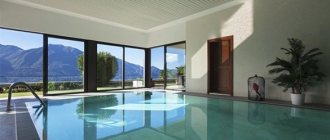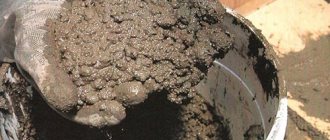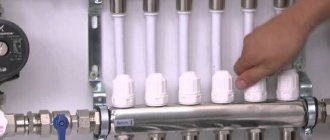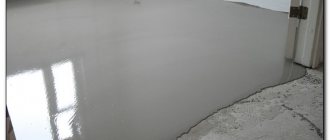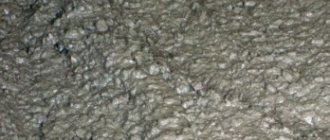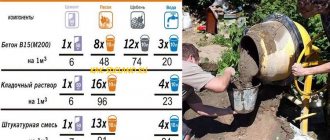Plasters are compositions based on a binder that are applied to walls and ceilings for various purposes.
There are antibacterial, decorative, “medicinal” and other types of plasters, but the bulk of plasters are used to level walls.
Important!
Plasters are called coatings with a thickness of 5 to 80 mm. Coatings thinner than 5 mm are called putties.
Applying plasters not only levels the surfaces and prepares them for further painting, wallpapering or tiling, but also insulates the premises and improves sound insulation.
Why is binder needed?
The binder components react with water and, as a result of chemical processes, a new substance is formed. Cement and water or lime and water separately and after reaction are completely different substances, so you cannot think that the solution simply dries out; it crystallizes, gains strength, and the final strength of the coating depends on how correctly the proportions of the binder component and water were maintained.
Sand
There are no trifles in the matter of plastering.
Plaster primarily levels surfaces, so the use of coarse or mixed-grade filler is unacceptable. Washed quarry or fine quartz sand is used in plaster mortars and must be sifted through a sieve with a mesh size of 1.5 mm, since even a small amount of small pebbles can spoil a perfectly smooth and even plastered surface.
Option with two binders
It’s not for nothing that we paid so much attention to CPS - this is the main composition for plastering the walls of most houses built from materials traditional for our country, and variations on its theme make it possible to create a real construction symphony. But its capabilities do not end there, because the introduction of the so-called. the second binder allows you to further expand the scope of its application.
Namely:
- if you add a little lime to the cement-sand mortar, it will become more elastic and behave better in rooms with high humidity;
- if you add a little clay to the cement-sand mortar, then such a solution, bringing the composition closer to the characteristics of a brick, will be less susceptible to cracking, but will soften the plaster; it is mainly used for plastering wooden walls.
What you absolutely cannot do is add gypsum to the composition of the DSP. Works great, especially on thick areas. The speed of work can be increased significantly. But such plaster will not last long, even indoors.
Why do you need a plasticizer for plaster mortar?
To prepare cement mortar, water and cement are mixed in certain proportions, which are called water-cement ratio. The ideal water-cement ratio is 0.45–0.55. But the mixture turns out to be very thick, heavy, and inflexible. It is difficult to lay, and it sets quite quickly, making further work difficult.
Adding more water seems like the logical thing to do. The mixture will immediately become more pliable, but the price of this convenience is reduced strength of the hardened coating.
A plasticizer helps to get out of this situation beautifully.
Lime-sand mortar
At home, this mixture is rarely used; the resulting plaster is too soft. The ratio is usually taken: 1 part lime to 2-4 parts sand. It was used (and is often used now) for plastering large areas in public buildings and structures. You can make a large quantity and, under certain conditions, keep it ready for weeks, using it up gradually. The solution is easy to use, probably the best for machine plastering, elastic and pliable.
As a rule, a strengthening finishing was provided for walls plastered with lime-sand mortar:
- painting in several layers;
- panel arrangement;
- facing corners or placing chamfers on them, etc.
For home use, I would not use it in its pure form, but experiment with using two binders, as described in the previous section.
But if we take slaked lime as a binder, and for filling we use the same quartz flour or various tiny particles of stones (practically dust): onyx, granite, quartz, etc., then we will get classic Venetian plaster. But only certain ways of working with it and finishing materials will make it uniquely beautiful.
What properties does a plasticizer give to plaster?
Adding a plasticizer makes the plaster more plastic, flexible, mobile and viscous, and also allows it to not set for longer, which means you can work at a calm pace or dilute more mortar at once. Plaster with plasticizer “lives” three times longer than a solution without this useful additive, that is, you can mix a solution and it will last for a whole day of work.
Important!
Cement mortars shrink during the hardening process, and as a result, cracks and detachments of the plaster from the surface may appear. To prevent this defect, a special reinforcing mesh is used, located between two layers of plaster. Naturally, the use of mesh complicates the coating process and significantly slows it down.
A replacement for the mesh is polypropylene fiber, which is added directly to the solution. Its advantages:
- light weight;
- ease of distribution in solution;
- harmless to the skin of the hands.
Plaster mortar with polypropylene fiber fiber is durable, shrinks less and does not develop cracks.
Why are they added?
The main advantages of introducing surfactant additives into concrete include:
- Increased fluidity and mobility of the solution, resulting in increased ease of placement, it fills the formwork better. The likelihood of voids forming, especially when filling frames of complex structures where vibration compaction is difficult, is reduced.
- Reducing the amount of water in the solution: it gains strength faster.
- Better grip on the surface (adhesion).
- Resistant to cracking and temperature changes. Frost resistance.
- Strengthening the water-repellent properties of plaster.
- Ensures uniform mixing and reduces the risk of water separation and segregation.
- Increasing the strength and service life of concrete.
According to the methods of action, all plasticizers can be divided into:
- Hydrophilic action. By increasing wettability, the formation time of colloids (particles mixed in a medium with another substance) is reduced, resulting in increased fluidity and plasticity.
- Hydrophobic. Enriched with air bubbles. Increase the plasticity of the mixture and the strength of the plaster.
According to the degree of effectiveness, plasticizers are divided into:
- Superplasticizers. Manufactured from melamine polymers.
- Hyperplasticizers. The composition contains polycarboxylates. More active than superplasticizers. Due to their high cost, they are mainly used to create thin-layer self-leveling mortars, for example, for self-leveling floors.
Selecting a plasticizer depending on the type of plaster
There are three main types of plaster mixtures based on the type of binder:
- cement;
- limestone;
- plaster.
Each type of plaster has its own pros and cons, so sometimes several binders are mixed to make combined plasters, for example, cement-lime, lime-gypsum. Plasticizers for different types of plaster may vary.
Cement plaster (sand-cement composition)
The composition of cement plaster includes:
- cement grades M150–M500 depending on the purpose of the coating;
- sand;
- water.
For one part by weight of cement, take from 3 to 5 parts of sand. Water is added to the required consistency.
Video: Preparation of plaster mortar
Advantages of cement plaster:
- high strength;
- moisture resistance;
- resistance to infection by fungus and mold.
Therefore, cement plaster has no restrictions on temperature and humidity conditions and is successfully used on building facades, for finishing walls in rooms with high humidity, and is used as a coating for subsequent laying of tiles.
But the cement mortar is very heavy, non-plastic and sets within 3-4 hours, after which it is no longer possible to work with it and you have to mix a new batch. It also tends to delaminate during storage.
To give the solution plasticity, mobility and increase its lifespan, add the following plasticizing additives:
- lime;
- detergent;
- PVA;
- ready-made plasticizers.
Adding lime
Lime is the cheapest plasticizer for cement plaster. Quicklime is used, which must first be slaked. It is then diluted to the consistency of milk; the resulting solution can be used for mixing cement plaster mortar.
Cement-lime mortar is more plastic, it is easier to process, and remains suitable for work longer.
Adding Detergents
At home, a common practice is to use detergents as plasticizing additives in cement mortars, including plaster.
The use of liquid soap as a plasticizer actually makes the plaster mixture more flexible, more flexible, increases its lifespan and prevents delamination. But can liquid soap be a full-fledged plasticizer?
The working components of any detergent, from dishwashing liquid to expensive shampoos, are surfactants (surfactants). They are cationic, anionic, amphoteric and nonionic. Different groups of surfactants vary significantly in properties, and their concentration in different types of detergents can vary significantly. Therefore, adding a conventional 50 ml of liquid soap to 10 liters of plaster mortar, we do not know how much and what type of surfactant we actually added, and how this additive will affect the properties of the mortar; accordingly, it is impossible to predict the behavior of the plaster.
Adding PVA
Polyvinyl acetate emulsion is used in cement mortars to increase plasticity and increase adhesion. Use PVA-MB glue or PVA dispersion at the rate of 50-100 ml per 1 liter of mixing water.
Moreover, cement-sand mortars are mixed on polyvinyl acetate emulsion without adding water; in this case, a particularly powerful solution is obtained for laying ceramic tiles.
The disadvantage of using PVA is the high consumption of this additive.
Addition of starch esters
Starch esters are added to plaster mixtures to prevent the plaster layer from slipping and for better adhesion.
Application of plasticizers
The use of detergents, while there are ready-made plasticizers and superplasticizers for cement mortars, seems unjustified.
Industrial plasticizers, for example CemStone, are designed specifically to give concrete mixtures and other mortars mobility, plasticity, prevent delamination and extend the time of working with the mortar.
Since a mixture with a plasticizer with the same mass has a larger volume than a solution without a plasticizer, it is consumed more economically and, due to its lightness, fits better and slides less under its own weight, which significantly reduces labor costs.
Plasticizers prevent shrinkage deformation and cracking of the coating and promote rapid strength gain.
Adding plasticizers does not increase the cost of the solution, because plasticizers are used in small quantities and at the same time allow saving cement without loss of strength.
Lime plaster
Lime-based plasters include hydrated lime, sand and water. The proportions of lime to sand are from 1:2 to 1:5.
Quicklime is supplied in the form of powder or dough in double bags; It must be extinguished before work.
Advantages of lime plaster mortars:
- plastic;
- high adhesion;
- ease of processing;
- cheapness;
- remains plastic for a long time;
- “breathes” and creates a favorable indoor microclimate.
The disadvantages of lime plaster include:
- long time to gain strength;
- instability to moisture;
- large shrinkage;
- low tensile strength, which means the possibility of cracking.
Lime plaster does not require the addition of plasticizers, since it is plastic and mobile.
To increase strength, cement is added to lime plaster, and gypsum is added to speed up setting and reduce shrinkage.
PVA glue is used as a strengthening additive at the rate of 50-100 ml per 1 liter of mixing water.
Lime-gypsum composition
Gypsum plasters are characterized by rapid hardening. Other advantages:
- efficiency;
- no shrinkage;
- plasticity and ease of installation.
Disadvantages of gypsum plaster:
- instability to moisture;
- low strength.
Therefore, gypsum compositions are used only for finishing dry rooms and are not recommended for laying tiles.
Lime-gypsum mortar is plastic, with good adhesion and low shrinkage. Thanks to the addition of gypsum, it sets faster and gains strength.
Adding PVA
Polyvinyl acetate emulsion is added to lime-gypsum compositions in order to increase the strength of the plaster.
Plasticizers
The use of CemStone plasticizer affects the chemical reaction of gypsum with water, increasing the strength of gypsum stone. Due to the effect of the plasticizer, gypsum is completely involved in the hydration reaction, and the increased plasticity of the mixture contributes to its self-compaction.
For further finishing work, it is important that the surface plastered with gypsum compositions with the addition of a plasticizer is more opaque, which reduces paint consumption during subsequent painting.
Plasticizer for cement - manufacturing rules
A plasticizer for cement is introduced in compliance with the required proportions:
- Liquid soap or shampoo with a volume of 0.2 liters is added to 50 kilograms of Portland cement when preparing concrete. The introduction of an additive at the initial mixing stage allows you to increase the hardening time of concrete by up to 3 hours. This is convenient for the production and pouring of increased volumes of concrete mixture.
- Slaked lime is mixed with the concrete mixture in an amount of no more than 20% of the weight of cement for finishing building facades and in a 1:1 ratio for interior work. The additive increases the elasticity of concrete and gives it adhesiveness, which makes it possible to carry out complex work, ensure uniform application and smooth masonry joints. An additional advantage is the high bactericidal properties of the resulting cement mortar.
- Washing powder is pre-diluted with water and added when mixing the composition at the rate of 0.1–0.15 kg per bag of cement. The powder-based additive slows down the hydration process, increasing the hardening threshold.
- Polyvinyl acetate adhesive (PVA) is mixed with pre-prepared concrete. For each bucket of concrete, 0.2 liters of glue is added, which increases the resistance of the cement mortar to moisture penetration.
The use of chicken egg white as a modifier has ancient roots. The introduced protein significantly increased the lifespan of buildings, many of which survived centuries. The recipe was passed down from generation to generation, but in our time it has lost its relevance when, thanks to the development of the chemical industry, many modern compounds produced industrially have appeared.
So, to make cement mixtures more plastic, you will need to use hair shampoo, liquid soap, liquid washing powder and lime
Proportions for adding plasticizers to solutions
In order to properly prepare a solution for plastering, it is important to observe the proportions of the components. The table will tell you in what ratios to mix the main components.
This table clarifies how to calculate the amount of materials for plastering 1 square meter. m of surface depending on the thickness of the plaster layer.
PVA is added to solutions at the rate of 50–100 ml per 1 liter of mixing water; the working concentration of polyvinyl acetate emulsion in the solution can reach 20% by weight of dry cement.
Modern plasticizers are economical and easy to use.
Plasticizer consumption is 0.5–1% by weight of the binder (cement, gypsum or lime). When calculating the dosage of the additive, it should be taken into account that gypsum is more active than cement and the amount of the additive may differ from the dosage of the additive with cement, therefore it is recommended to carry out trial use in plaster mortars.
Why add additives to plaster?
Any plaster is mixed based on a binder - cement, gypsum, polymers. After dilution, it can be used to decorate walls and ceilings, arches and other structures. Special substances that are used at the stage of mixing plaster help it acquire new properties:
- the plastic mixture is easy to apply, leveled without problems, and this seriously reduces labor costs;
- after rubbing, the plaster does not peel off and adheres perfectly to the surface;
- with the help of additives you can extend the period until the mass sets; it can be used almost 3 times longer;
- the durability of the finish increases, it does not shrink, and cracks do not appear on it;
- the dried plaster layer will not be afraid of temperature changes, frost, moisture (depending on the type of substance introduced).
Clay-sand solutions
In its pure form, clay-sand mortar is nowadays used mainly for laying stoves and fireplaces in a ratio of 1x2 (3), although even here it is gradually being pushed into the shadows by special masonry mortars. But for plastering work, it is necessary to introduce into it, in addition to sand, sawdust, chaff, sunflower husks, etc. Of course, now you can use fiber.
For a long time I have not heard of anyone using such a composition to plaster the walls of their house - only when repairing stoves. But in my house the walls of the hall are plastered with it and quite roughly - in an antique style.
This was also done for additional regulation of humidity in the room, which, although through double doors, had two through exits to the street.
We recommend other articles on the topic
Choosing silver paint | How to dilute and apply
Fireclay clay - selection and use of refractory clay
Fire-resistant foam - choice of non-flammable foam
MDF panels for walls - variety of applications, subtleties of choice
How to make a solution for plastering walls
Any room, even non-residential or used for auxiliary or technological purposes, requires a certain kind of plaster for the internal and external surfaces of the walls. First of all, this is the only way to prepare a wall for painting and at the same time correct construction defects in the walls, hide cracks or make the surface more or less smooth and pleasing to the eye. You can even do it yourself.
Ready-made plaster mixtures
It is easier for beginners to use ready-made plaster mixtures produced by various companies. The finished mixture already contains various additives, so you can’t expect “surprises” from the behavior of the solution when laying it on the wall and hardening the mass. The packaging contains information on how to properly make the batch, the specifics of the composition and its characteristics.
Dry mixtures are prepared according to the instructions that can be found on the packaging. During transportation, partial settling of heavier filler particles in the packaging is possible. Therefore, in order to avoid some deviations in the composition of different batches, it is recommended to dilute the dry mixture entirely (the entire package).
Ready-made formulations have an expiration date. It is better to purchase mixtures that are still far from expiration date. To ensure that the finish on large walls is uniform, it is better to take mixtures for preparing plaster from one batch.
Preparing a solution for plaster is a seemingly simple job. But the quality and properties of the finish depend on how well and correctly the plaster batch is prepared.
Necessary tools and materials for work
To prepare mortar for plaster, you need the appropriate tools and equipment. You can mix the plaster manually (with a shovel in a trough) or in a mortar mixer (mechanically). It all depends on the amount of work and capabilities. To mix a small portion, you can use a mixer.
To get started, you should purchase the appropriate materials in advance with a reserve (about 20%):
- individual components or dry mixtures ready for mixing;
- color or pigments;
- prepare clean water (tap or rain);
- additives (available in hardware stores);
- containers;
- a shovel is useful for pouring filler into the mortar mixer;
- To open the packages you will need a knife;
- trowel (and other tools for applying compounds).
Specifics of plaster compositions
Since buildings need to be plastered outside and inside, where the finishing is exposed to different conditions for a long time, the compositions of plastering solutions are also specific. Facade surfaces are subjected to more severe mechanical stress, are watered by rain, hit by hail, endure frost and heat, and are scorched by direct sunlight. Therefore, solutions for external conditions should be more resistant to all these “troubles”.
There are mixtures for facades, interior work and universal ones. The latter can be equally used for outdoor and indoor decoration.
All basic data on the proportions of plaster solutions for exterior and interior decoration are contained in the table from the standard.
spray and soil during external and internal plastering
The following figure shows the proportions of the covering.
cover - proportions
Composition of mortar for plastering external walls
Mortars for external walls differ in their base. Gypsum and lime compounds are not used for exterior finishing. An exception is plastering of closed loggias and balconies, where there is protection from water ingress. Therefore, the main binder for facade compositions is cement. Cement-lime (popular) and cement-polymer (more expensive) compositions are also used.
Clay is not afraid of frost and sunlight. But clay plaster must be protected from erosion. For facades in regions with a dry climate, if water does not directly fall on the plaster, plastering with lime-clay and lime-gypsum mixtures is used.
